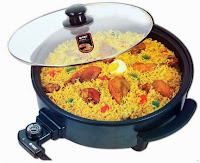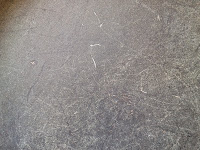For a long time now, non-stick cookware and bakeware have outsold cast-iron pans year on year making them an integral part of our daily lives. But what is it that makes them seem so indispensable? The idea of eating healthy food is one major reason why non-stick cookware or bakeware will remain apart of our lives for generations to come. All animal fat based cooking oils that we use for baking, frying, etc contain cholesterol responsible for promoting atheroma development - a condition that causes heart attacks, strokes and peripheral vascular diseases. According to WHO, experts believe many of the chronic diseases we are faced with today, like the aforementioned, result from having saturated fat diets. So they advocate for fat free foods like fruits, whole grain and vegetables; so as to mitigate the risk posed by these chronic diseases.
Most nonstick pans are lined with a nonstick coating based on polytetrafluoroethylene (PTFE) or silicone polyester compounds according to the Cookware Manufacturers Association (CMA). Nonstick coatings naturally repel water, that is why food is pushed off the pan because food releases water with a rise in temperature. Majority of the nonstick coatings are based on similar formulations what varies are the manufacturing processes involved for the various nonstick pan applications. For instance, materials chosen for making cookware products differ from those for making bakeware products.
Common base materials used for making the best cookware and bakeware
Aluminum
Aluminum is the most commonly used and preferred material for cookware. Having a high thermal conductivity makes aluminum highly energy efficient and suitable for fast, even cooking. Aluminum is also one of the most abundant and cheapest metals on earth. Although being a lightweight and porous material, it means that aluminum will stain when brought in contact with extreme heat or deep-colored foods.Stainless Steel
Stainless steel adds natural beauty to the cookware world. It can virtually take any rough handling, is dishwasher safe, chip and scratch resistant, and has a shiny bright look. It is not as good a conductor of heat than aluminum but can be improved by lining its bottom with an aluminum or copper cladding.Hard Anodized aluminum
If you want to make an investment that will last you a lifetime, hard anodized aluminum is the ultimate choice you can make. It is the most durable and hardest material used in cookware today - even harder than steel. But the durability and extra strength does not come cheap!Carbon Steel
Carbon steel is commonly used as a bakeware material because it is heavy and affordable. But being prone to rusting, it requires an insulation coating normally a non-stick coating both on the interior and exterior.When and how is the nonstick coating applied to the pan?
First of all, a nonstick coat is The are two ways of applying the nonstick coat; either by hand spraying a nonstick coat directly onto an already molded pan or by applying one to three continuous layers of nonstick material to a sheet of base material (such as aluminum or stainless steel) before being molded into a pan.A nonstick coating comprises of a number of ingredients, namely;
- A adhesive resin to make the non-stick coat bind well to the pan surface
- A release(nonstick) agent which is either a variant of PTFE or silicone compound.
- A carrier which is an organic solvent or water that carries the ingredients for deposition during the manufacture process but is evaporated off when the pan is cured or dried.
- A coloring pigment that gives the nonstick coat its characteristic color
- Optional reinforcing agents to give the nonstick coat extra resistance to wear and tear. For instance Swiss Diamond reinforce their nonstick coat with diamond crystals to give the pans a long life, resistant to chipping and scratches.
Are nonstick pans safe to use in your kitchen?
There have been several concerns raised by health experts and authorities alike about the health risks associated with PTFE or Teflon - a trademark name under which PTFE is marketed. Teflon itself is chemically inert - does not react with anything. However, this fluoropolymer starts to degrade above 260°C (500°F), releasing fluorocarbon gases and other fumes into the air. These fumes are not toxic to humans, but can cause temporary flu-like symptoms in humans and could be fatal to birds, which have sensitive respiratory systems. It should be noted though that 500°F is well above the required temperature for boiling, baking and frying. Teflon should remain safe for normal cooking conditions.Additionally, all nonstick coatings are bound to degrade with time depending on handling, care and quality of nonstick pan. Longer lasting nonstick pans are coated with more layers with a reinforcing agent, and can last several years if handled according to the manufacturers guidelines. Some nonstick pans maybe labelled metal and dishwasher safe in which case you are free to use your metallic spatulas with this type of pan.
Even when nonstick coating begins to chip off due to scratches, the pan can still be used with no health risk because partly; it is not likely that you will ingest an appreciable amount of the nonstick coating, and secondly, PTFE has been labelled generally safe from extensive use of over a period more than 50years. It has in effect been included on the list of substances Generally Recognized As Safe (GRAS). Today, DuPont Teflon is used in many applications including but not limited to paint, cable insulation, carpets, fabrics, clothing, home furnishings etc.
Care for your nonstick cookware and bakeware
- Nonstick pans are fragile and yet expensive. You might need a new one when the coating becomes 'significantly' scratched or starts to chip. Even if the nonstick interior is labelled metal utensil safe by the manufacturer, in order to prolong the life of your cookware use wooden, silicone, or plastic utensils.
- Never heat your nonstick cookware above 500°F, because above this temperature, the behavior of the nonstick coating is unpredictable.
- Never use abrasive cleaners with your nonstick. Instead hand wash with warm soapy water and sponge.
- Avoid using cooking sprays because they contain lecithin, which gives off a gummy residue that interferes with the nonstick properties of coat.
- Always allow your pan to cool off before washing it. Avoid sudden changes in temperature.
Common and trusted cookeware and bakeware brands
- Teflon from DuPont
- T-Fal
- Calphalon
- Swiss Diamond
- Scanpan
- Anolon
- KitchenAid
- All-Clad Cookware
- Prestige
- Nordic ware
- Meyer Cookware
- Staub Cookware
- Chasseur Cookware





Nice and informative blog! The nonstick cookware from premium brand like Tefal comes with a plethora of fruitful features. Its first and foremost advantage is that the prepared food does not stick to the appliance, hence, it is very easy to clean, very easy to maintain and fantabulous in use.
ReplyDeleteThis cookware bakeware set has multilayer nonstick which offers easy tossing and flipping and allows healthy cooking.
ReplyDeleteNow a day Nonstick Cookware
ReplyDeletebecome the essential part of every kitchen. nice content on this topic.